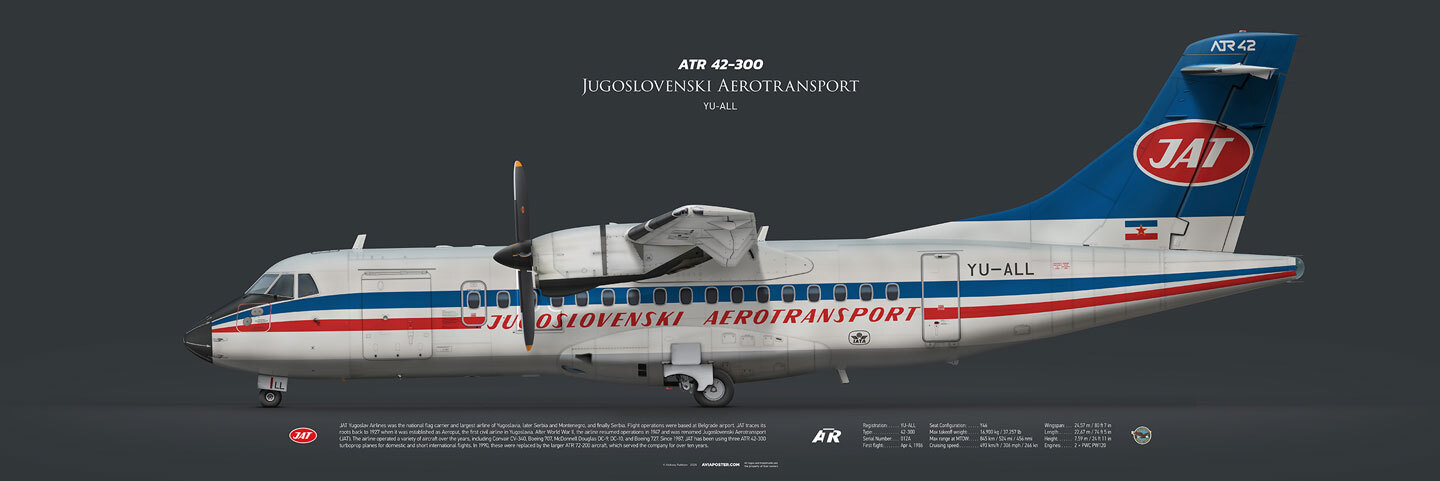Once upon a time, the skies of Europe, Asia, North America, and even Australia were graced by planes bearing the simple yet striking "JAT" logo. This was Yugoslav Airlines, the national carrier of Yugoslavia – a symbol of an era when the country stood proudly between East and West. Though JAT no longer exists, its story is more than a mere chronicle of highs and lows; it’s a tale of dreams, ambitions, and the twists of fate. Let’s take a journey through its winged past.
The Birth of a Dream: From Aeroput to JAT
The story of JAT begins not with the airline itself, but with its predecessor, Aeroput – the first civil aviation company in Yugoslavia, founded on June 17, 1927. It was an era when aviation was just beginning to weave itself into everyday life. Aeroput, launched by a group of enthusiasts led by Tadija Sondermajer, a Serbian military pilot and aviation pioneer, started modestly with four Potez 29/2 biplanes. Its first international flight in 1929, from Belgrade to Graz (Austria), became a symbol of the young nation’s ambitions.
The Birth of a Dream: From Aeroput to JAT
The story of JAT begins not with the airline itself, but with its predecessor, Aeroput – the first civil aviation company in Yugoslavia, founded on June 17, 1927. It was an era when aviation was just beginning to weave itself into everyday life. Aeroput, launched by a group of enthusiasts led by Tadija Sondermajer, a Serbian military pilot and aviation pioneer, started modestly with four Potez 29/2 biplanes. Its first international flight in 1929, from Belgrade to Graz (Austria), became a symbol of the young nation’s ambitions.
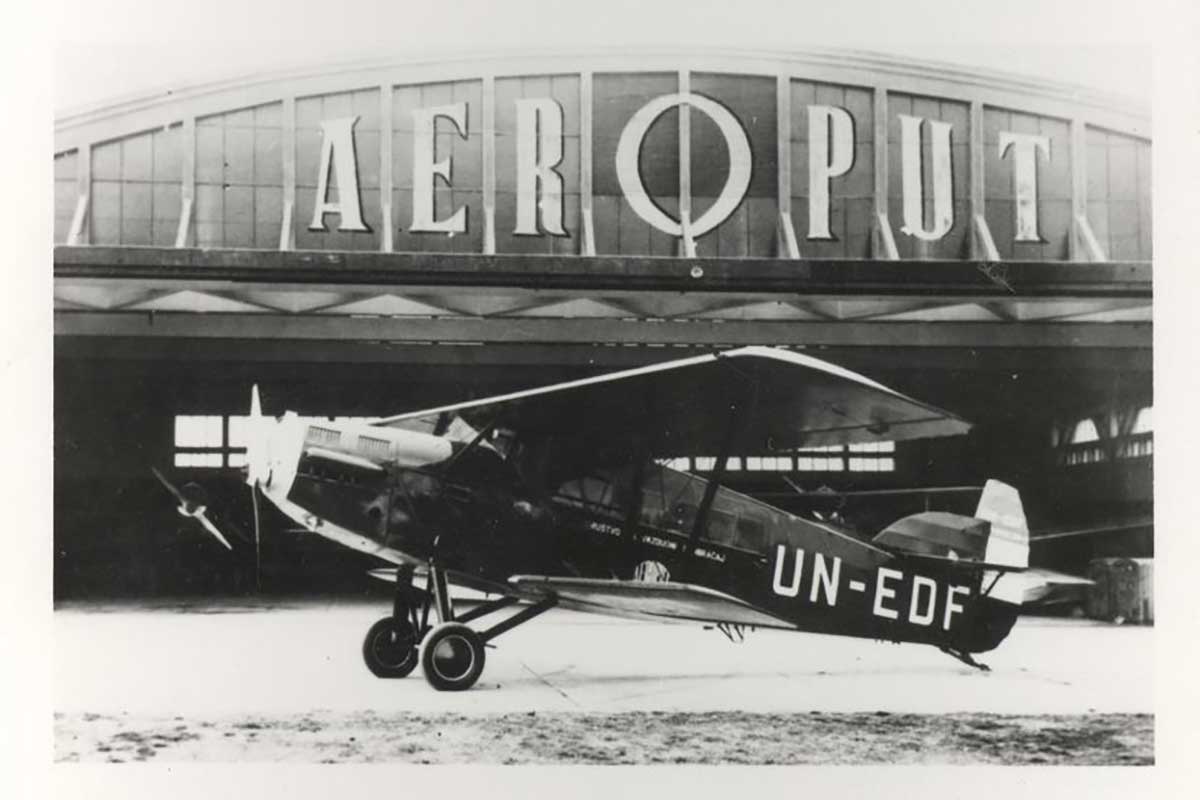
By the 1930s, Aeroput had grown, connecting Yugoslavia to cities across Central and Southern Europe – from Prague to Thessaloniki. The fleet expanded with American Lockheed Electra aircraft and other models, making the airline a source of pride for the Kingdom of Yugoslavia. But World War II halted this ascent: many planes were flown to England to serve the Royal Air Force (RAF), and the company lay dormant until better days arrived.
After the war, in 1945, Yugoslavia emerged reshaped under the leadership of Josip Broz Tito. The privately owned Aeroput was nationalized, and on April 1, 1947, a new chapter took flight with the first journey of Jugoslovenski Aerotransport – or simply JAT. With three Douglas C-47 Skytrains and a handful of Junkers Ju 52s, a new era began.
Between East and West: The Golden Age of JAT
Under Tito, Yugoslavia carved out a unique path – independent of both Eastern and Western blocs, it became a leader of the Non-Aligned Movement. JAT mirrored this stance: an airline that could purchase Western aircraft and fly to destinations off-limits to other socialist carriers. The "Golden Age" of JAT – the 1970s and 1980s – was a time when its fleet and routes reached their zenith, and the operation of its planes became a true art form.
Jet-Powered Beginnings and the First "Americans"
By the 1960s, JAT had moved beyond piston-engine veterans like the Douglas C-47 into the jet age. In 1963, the airline introduced the French Sud Aviation Caravelle VI-N – its first jet aircraft. Powered by twin Rolls-Royce Avon engines, these sleek machines became the backbone of European routes, linking Belgrade with Paris, Frankfurt, and Zurich. Known for their reliability and comfort, the Caravelles marked JAT’s leap into modernity.
The real breakthrough came in 1969 with the acquisition of American Douglas DC-9-32s. Seating 115 passengers, these planes became the workhorses of short- and medium-haul flights. The DC-9s were prized for their ease of maintenance and fuel efficiency – key traits for an airline eager to expand without breaking the bank. Operating them required JAT to build new infrastructure: modern hangars sprang up at Belgrade’s airport, and engineers trained in the United States. By the late 1970s, the fleet boasted 16 of these aircraft, enabling flights to Cairo, Istanbul, and even Helsinki.
Boeing 707 and the Leap to Long-Haul
JAT’s ambitions stretched beyond Europe. In 1970, the airline took a bold step by leasing a Boeing 707-320C from Pan Am before purchasing its own. These four-engine giants ushered in the era of long-haul flights. JAT’s first Boeing 707 flight to New York took off in April 1970, soon followed by routes to Chicago, Toronto, and even Sydney. Operating the "707s" was a challenge: they guzzled more fuel than the DC-9s and demanded complex maintenance. JAT established supply chains for parts from the U.S. and trained pilots and technicians in advanced navigation and control systems.
The Boeing 707s weren’t just for passengers. In cargo configuration, they ferried goods to Middle Eastern and African nations, bolstering Yugoslavia’s economic ties. By the mid-1970s, however, they gave way to more advanced models.
After the war, in 1945, Yugoslavia emerged reshaped under the leadership of Josip Broz Tito. The privately owned Aeroput was nationalized, and on April 1, 1947, a new chapter took flight with the first journey of Jugoslovenski Aerotransport – or simply JAT. With three Douglas C-47 Skytrains and a handful of Junkers Ju 52s, a new era began.
Between East and West: The Golden Age of JAT
Under Tito, Yugoslavia carved out a unique path – independent of both Eastern and Western blocs, it became a leader of the Non-Aligned Movement. JAT mirrored this stance: an airline that could purchase Western aircraft and fly to destinations off-limits to other socialist carriers. The "Golden Age" of JAT – the 1970s and 1980s – was a time when its fleet and routes reached their zenith, and the operation of its planes became a true art form.
Jet-Powered Beginnings and the First "Americans"
By the 1960s, JAT had moved beyond piston-engine veterans like the Douglas C-47 into the jet age. In 1963, the airline introduced the French Sud Aviation Caravelle VI-N – its first jet aircraft. Powered by twin Rolls-Royce Avon engines, these sleek machines became the backbone of European routes, linking Belgrade with Paris, Frankfurt, and Zurich. Known for their reliability and comfort, the Caravelles marked JAT’s leap into modernity.
The real breakthrough came in 1969 with the acquisition of American Douglas DC-9-32s. Seating 115 passengers, these planes became the workhorses of short- and medium-haul flights. The DC-9s were prized for their ease of maintenance and fuel efficiency – key traits for an airline eager to expand without breaking the bank. Operating them required JAT to build new infrastructure: modern hangars sprang up at Belgrade’s airport, and engineers trained in the United States. By the late 1970s, the fleet boasted 16 of these aircraft, enabling flights to Cairo, Istanbul, and even Helsinki.
Boeing 707 and the Leap to Long-Haul
JAT’s ambitions stretched beyond Europe. In 1970, the airline took a bold step by leasing a Boeing 707-320C from Pan Am before purchasing its own. These four-engine giants ushered in the era of long-haul flights. JAT’s first Boeing 707 flight to New York took off in April 1970, soon followed by routes to Chicago, Toronto, and even Sydney. Operating the "707s" was a challenge: they guzzled more fuel than the DC-9s and demanded complex maintenance. JAT established supply chains for parts from the U.S. and trained pilots and technicians in advanced navigation and control systems.
The Boeing 707s weren’t just for passengers. In cargo configuration, they ferried goods to Middle Eastern and African nations, bolstering Yugoslavia’s economic ties. By the mid-1970s, however, they gave way to more advanced models.
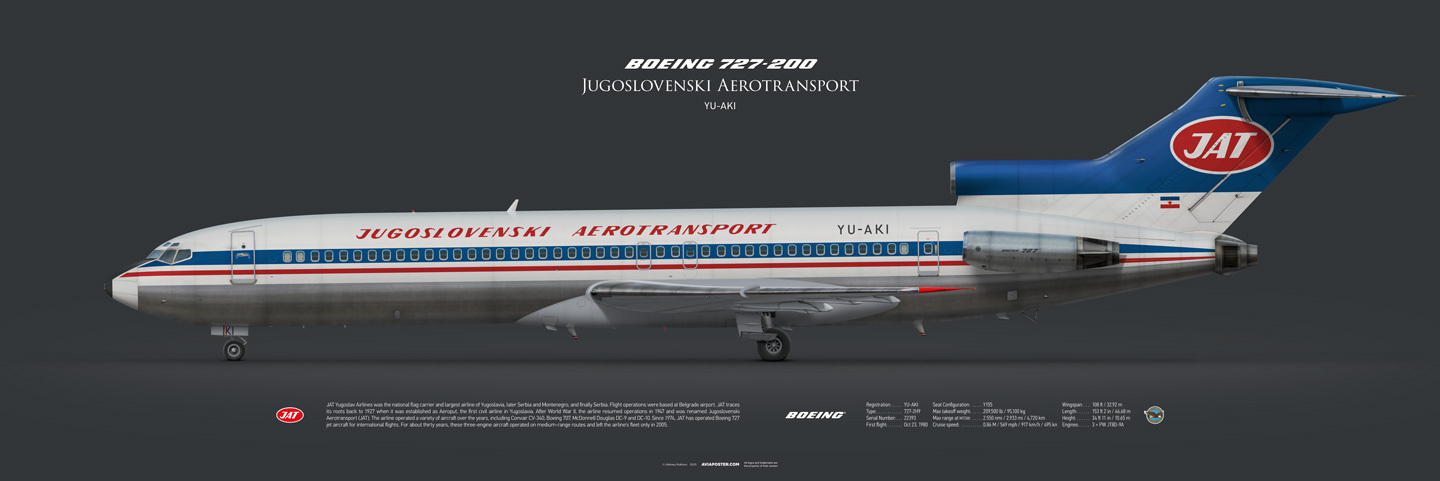
Boeing 727 and DC-10: The Pinnacle of Capability
In 1974, JAT introduced the Boeing 727-200 – a three-engine jet perfect for medium-range flights. These planes became the backbone of routes across Europe and North Africa. Their versatility shone through: they could land on the short runways of smaller airports like Tivat or Dubrovnik, a boon during Yugoslavia’s tourism boom. By the 1980s, JAT operated 10 of these aircraft, setting a standard for efficiency with minimal ground time, swift turnarounds, and rock-solid reliability.
The true crown jewel, however, was the McDonnell Douglas DC-10-30, introduced in 1978. This wide-body behemoth, seating up to 270 passengers, was built for long-haul journeys. With the DC-10, JAT solidified its North American presence, adding destinations like Cleveland and Los Angeles, while launching routes to Singapore and Beijing. Operating the DC-10 was a feat of engineering prowess: a massive hangar was built in Belgrade to service them, and crews trained in the U.S. and Switzerland. Flying nearly round-the-clock with up to 90% load factors, these planes proved profitable despite their thirst for fuel.
Boeing 737 and a Technological Leap
In 1985, JAT became Europe’s first operator of the Boeing 737-300. Equipped with new CFM56 engines, this aircraft was quieter and more fuel-efficient than its predecessors. The "300s" replaced aging DC-9s on key routes like Belgrade to London and Belgrade to Moscow. Their operation underscored JAT’s modernity: advanced avionics, lower fuel consumption, and enhanced passenger comfort. By the late 1980s, the fleet included five of these planes, symbolizing the airline’s final surge before the storm.
In 1974, JAT introduced the Boeing 727-200 – a three-engine jet perfect for medium-range flights. These planes became the backbone of routes across Europe and North Africa. Their versatility shone through: they could land on the short runways of smaller airports like Tivat or Dubrovnik, a boon during Yugoslavia’s tourism boom. By the 1980s, JAT operated 10 of these aircraft, setting a standard for efficiency with minimal ground time, swift turnarounds, and rock-solid reliability.
The true crown jewel, however, was the McDonnell Douglas DC-10-30, introduced in 1978. This wide-body behemoth, seating up to 270 passengers, was built for long-haul journeys. With the DC-10, JAT solidified its North American presence, adding destinations like Cleveland and Los Angeles, while launching routes to Singapore and Beijing. Operating the DC-10 was a feat of engineering prowess: a massive hangar was built in Belgrade to service them, and crews trained in the U.S. and Switzerland. Flying nearly round-the-clock with up to 90% load factors, these planes proved profitable despite their thirst for fuel.
Boeing 737 and a Technological Leap
In 1985, JAT became Europe’s first operator of the Boeing 737-300. Equipped with new CFM56 engines, this aircraft was quieter and more fuel-efficient than its predecessors. The "300s" replaced aging DC-9s on key routes like Belgrade to London and Belgrade to Moscow. Their operation underscored JAT’s modernity: advanced avionics, lower fuel consumption, and enhanced passenger comfort. By the late 1980s, the fleet included five of these planes, symbolizing the airline’s final surge before the storm.
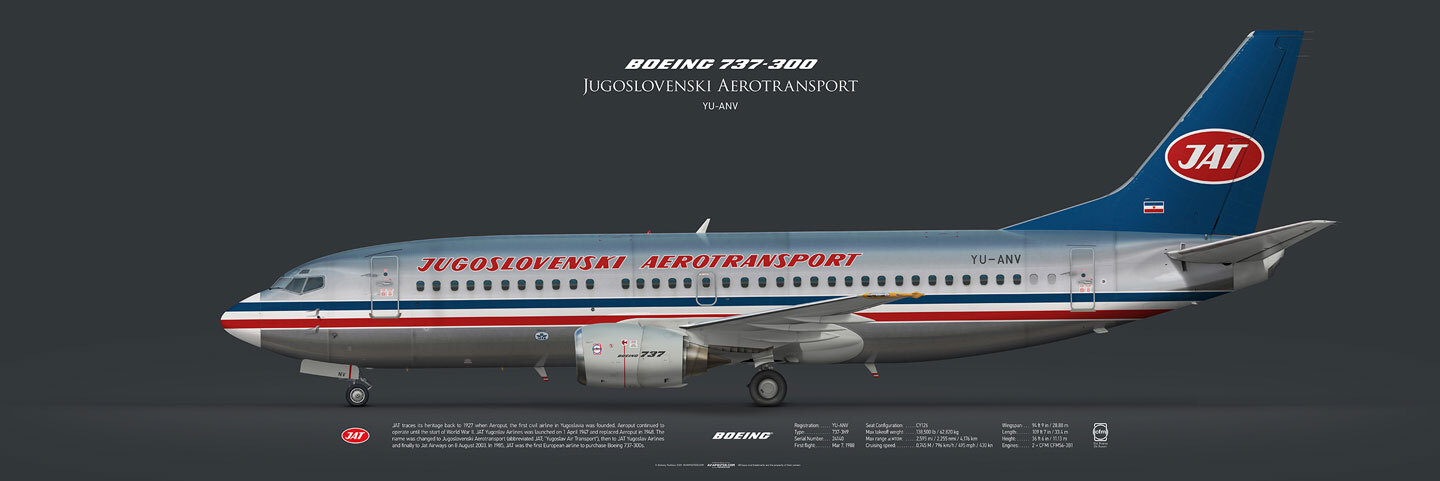
Logistics and Style
Operating such a diverse fleet – from compact Boeing 737s to mighty DC-10s – demanded precision. Parts arrived from the U.S., France, and the UK, a rarity for a socialist nation. Belgrade’s airport buzzed with activity: technicians trained abroad maintained planes in sprawling hangars, while pilots, often skilled on multiple aircraft types, wore modernist Yugoslav uniforms – sharp yet distinctive. The iconic red-white-blue livery became a familiar sight worldwide. But what truly set JAT apart was its flight geography, spanning from Canada to China.
At its peak, JAT connected 76 destinations across 39 countries, each with its own story. Europe was the network’s core: regular flights to London, Paris, Frankfurt, Rome, and Moscow served business travelers and tourists discovering the Adriatic. Yet JAT didn’t stop there. North America was a vital frontier: flights to New York (JFK) began in 1970 with the Boeing 707, later expanding to Chicago, Toronto, Cleveland, and Los Angeles. These routes were lifelines, linking the Yugoslav diaspora to their homeland with passengers, letters, and care packages.
To the east, JAT reached Asia. Singapore and Beijing joined the schedule thanks to the DC-10, reflecting Yugoslavia’s ties to the Non-Aligned Movement. Flights to China were a rarity among European carriers, and JAT pioneered them, carrying diplomats, businessmen, and curious travelers. The Middle East was within reach too: Beirut, Baghdad, and Cairo flights highlighted Yugoslavia’s economic and political ambitions, while cargo Boeing 707s delivered goods to Libya and Syria.
Perhaps the most striking route was Sydney. Launched in the 1970s, flights to Australia became a lifeline for Yugoslav workers seeking opportunity "Down Under." The Belgrade–Sydney route, with stops in Athens or Singapore, was among JAT’s longest, and the DC-10 handled it brilliantly, carrying up to 250 passengers per trip. It became legendary – few airlines of the era could boast regular service to the other side of the globe.
Africa wasn’t overlooked either: flights to Tripoli and Tunis supported trade links, and in the 1980s, JAT even eyed Johannesburg, though sanctions derailed those plans. Within the Balkans, a dense network connected Tivat, Split, Ljubljana, and Sarajevo, serving tourists and locals alike with Boeing 727s and DC-9s.
This vast geography demanded not just logistics but adaptability. JAT excelled at both: short runways in Tivat tested pilots’ skills, while long-haul flights to Sydney required precise fuel planning and seamless ground support. By 1988, five million passengers a year testified to a triumph fueled by the courage to fly where others dared not.
Operating such a diverse fleet – from compact Boeing 737s to mighty DC-10s – demanded precision. Parts arrived from the U.S., France, and the UK, a rarity for a socialist nation. Belgrade’s airport buzzed with activity: technicians trained abroad maintained planes in sprawling hangars, while pilots, often skilled on multiple aircraft types, wore modernist Yugoslav uniforms – sharp yet distinctive. The iconic red-white-blue livery became a familiar sight worldwide. But what truly set JAT apart was its flight geography, spanning from Canada to China.
At its peak, JAT connected 76 destinations across 39 countries, each with its own story. Europe was the network’s core: regular flights to London, Paris, Frankfurt, Rome, and Moscow served business travelers and tourists discovering the Adriatic. Yet JAT didn’t stop there. North America was a vital frontier: flights to New York (JFK) began in 1970 with the Boeing 707, later expanding to Chicago, Toronto, Cleveland, and Los Angeles. These routes were lifelines, linking the Yugoslav diaspora to their homeland with passengers, letters, and care packages.
To the east, JAT reached Asia. Singapore and Beijing joined the schedule thanks to the DC-10, reflecting Yugoslavia’s ties to the Non-Aligned Movement. Flights to China were a rarity among European carriers, and JAT pioneered them, carrying diplomats, businessmen, and curious travelers. The Middle East was within reach too: Beirut, Baghdad, and Cairo flights highlighted Yugoslavia’s economic and political ambitions, while cargo Boeing 707s delivered goods to Libya and Syria.
Perhaps the most striking route was Sydney. Launched in the 1970s, flights to Australia became a lifeline for Yugoslav workers seeking opportunity "Down Under." The Belgrade–Sydney route, with stops in Athens or Singapore, was among JAT’s longest, and the DC-10 handled it brilliantly, carrying up to 250 passengers per trip. It became legendary – few airlines of the era could boast regular service to the other side of the globe.
Africa wasn’t overlooked either: flights to Tripoli and Tunis supported trade links, and in the 1980s, JAT even eyed Johannesburg, though sanctions derailed those plans. Within the Balkans, a dense network connected Tivat, Split, Ljubljana, and Sarajevo, serving tourists and locals alike with Boeing 727s and DC-9s.
This vast geography demanded not just logistics but adaptability. JAT excelled at both: short runways in Tivat tested pilots’ skills, while long-haul flights to Sydney required precise fuel planning and seamless ground support. By 1988, five million passengers a year testified to a triumph fueled by the courage to fly where others dared not.
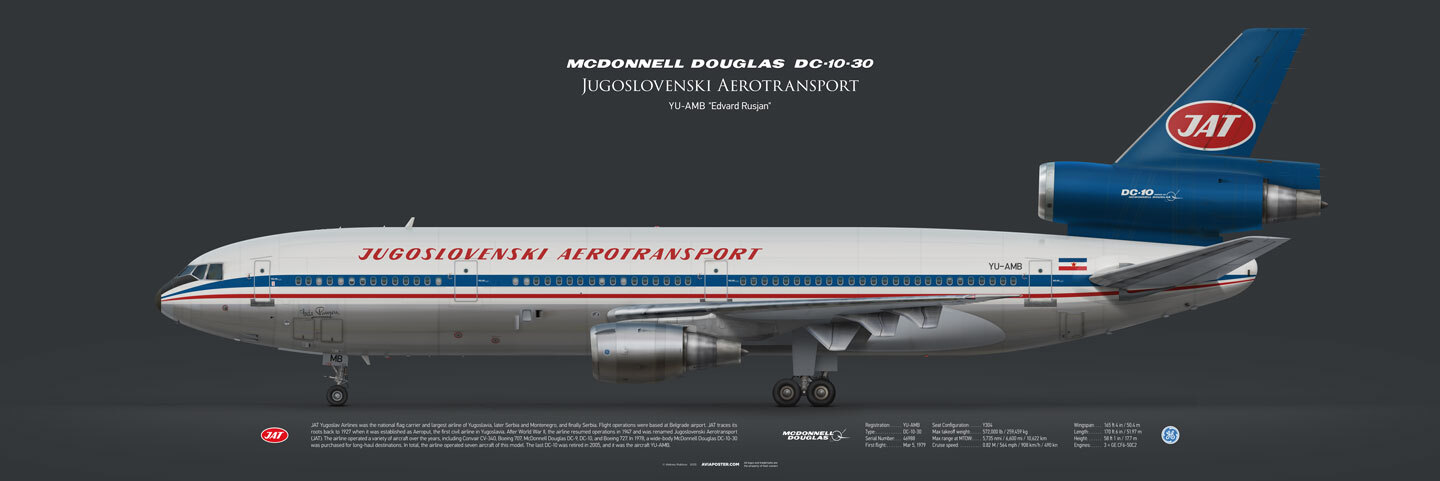
Dark Times: Wars and Sanctions
JAT’s story is inseparable from Yugoslavia’s fate. In the 1990s, the country began to fracture, and the airline found itself at the heart of the crisis. The Balkan wars and UN sanctions imposed in May 1992 severed international routes. Flights to the U.S. and Canada ceased, and the fleet sat idle. JAT was reduced to domestic hops between Belgrade, Podgorica, and a handful of cities in a shrinking nation.
Sanctions battered its finances and reputation. Planes aged, modernization stalled. In 1998, JAT ordered eight Airbus A319s, but debts scuttled the deal. By the early 2000s, the once-mighty airline was a shadow of its former self.
Rebirth and Farewell: From JAT to Air Serbia
After the fall of Milošević in 2000 and the lifting of sanctions, JAT tried to revive. On August 8, 2003, it rebranded as Jat Airways, dropping "Yugoslav" as a nod to a bygone era. Aging Boeing 727s and DC-9s were phased out, but financial woes lingered. In 2005, the last DC-10 was sold, and dreams of resuming North American flights faded.
By 2013, Jat Airways teetered on bankruptcy. Rescue came from Etihad Airways: on August 1, 2013, a strategic partnership was signed, with Etihad taking a 49% stake. On October 26 that year, Jat Airways became Air Serbia. The JAT brand slipped into history, making way for a new name and new hope.
The Legacy of JAT
JAT was more than an airline – it was a symbol of Yugoslavia, a nation that reached for the skies amid political storms. Its planes spanned the globe from Australia to America; its flight attendants, like Vesna Vulović, who survived a 1972 crash from 10 kilometers up, became legends. Today, Air Serbia carries on the tradition, but for many, JAT remains a memory of a time when Yugoslavia soared.
JAT’s story is inseparable from Yugoslavia’s fate. In the 1990s, the country began to fracture, and the airline found itself at the heart of the crisis. The Balkan wars and UN sanctions imposed in May 1992 severed international routes. Flights to the U.S. and Canada ceased, and the fleet sat idle. JAT was reduced to domestic hops between Belgrade, Podgorica, and a handful of cities in a shrinking nation.
Sanctions battered its finances and reputation. Planes aged, modernization stalled. In 1998, JAT ordered eight Airbus A319s, but debts scuttled the deal. By the early 2000s, the once-mighty airline was a shadow of its former self.
Rebirth and Farewell: From JAT to Air Serbia
After the fall of Milošević in 2000 and the lifting of sanctions, JAT tried to revive. On August 8, 2003, it rebranded as Jat Airways, dropping "Yugoslav" as a nod to a bygone era. Aging Boeing 727s and DC-9s were phased out, but financial woes lingered. In 2005, the last DC-10 was sold, and dreams of resuming North American flights faded.
By 2013, Jat Airways teetered on bankruptcy. Rescue came from Etihad Airways: on August 1, 2013, a strategic partnership was signed, with Etihad taking a 49% stake. On October 26 that year, Jat Airways became Air Serbia. The JAT brand slipped into history, making way for a new name and new hope.
The Legacy of JAT
JAT was more than an airline – it was a symbol of Yugoslavia, a nation that reached for the skies amid political storms. Its planes spanned the globe from Australia to America; its flight attendants, like Vesna Vulović, who survived a 1972 crash from 10 kilometers up, became legends. Today, Air Serbia carries on the tradition, but for many, JAT remains a memory of a time when Yugoslavia soared.
